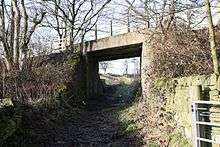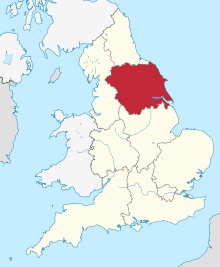Meltham branch line
Meltham branch line | |||||||||||||||||||||||||||||||||||||||||||||||||||||||||||||||||||||||||||||
|---|---|---|---|---|---|---|---|---|---|---|---|---|---|---|---|---|---|---|---|---|---|---|---|---|---|---|---|---|---|---|---|---|---|---|---|---|---|---|---|---|---|---|---|---|---|---|---|---|---|---|---|---|---|---|---|---|---|---|---|---|---|---|---|---|---|---|---|---|---|---|---|---|---|---|---|---|---|
| |||||||||||||||||||||||||||||||||||||||||||||||||||||||||||||||||||||||||||||
The Meltham branch line is a disused railway line that ran for 3 1⁄2 miles (5.6 km) from Lockwood to Meltham, in West Yorkshire, England. The line was single track for its entire length. The last regular passenger service was on 21 May 1949. It closed completely on 3 April 1965.
History

The line was authorised by the Lancashire and Yorkshire Railway Act of 7 June 1861.[1] Construction began in April 1864 and the line opened to freight on 10 August 1868 with the first train carrying coal and lime. Passenger services began on 5 July 1869. The line was used to transport tractors from the David Brown tractor factory at Meltham.
The first sod of the Huddersfield- Meltham Railway line was lifted on 4 April 1864, by Mr. Charles Brook, of Enderby Hall, in a field near Meltham Mills. Rain fell heavily during the ceremony, but there were many people present. Mr. James Wrigley, of Netherton, presented the spade, and Mr. Brook then cut three sods, placed them in a wheelbarrow, wheeled it along a platform, and then tossed them out! The Act of Parliament for the construction of this Railway was obtained in 1861. Mr. Perrin, of Manchester, was the surveyor, and Mr. Brown, engineer, also of Manchester, superintended the building.
The construction of this single line was a most expensive piece of railway engineering, as two tunnels, the Butternab tunnel (325 yards long) and the Netherton tunnel (210 yards long) had to be excavated before the line could proceed to Netherton, while five embankments (one at Dungeon) had to be made, besides the railway stations at Netherton, Healey House and Meltham. There was also a station at Woodfield, on the low side of Beaumont Park, at one time.
It was computed that the line took five years, three months and one day to be built before it was eventually opened for passenger traffic.
The first sod of the Netherton tunnel was cut by Mr Joe Mellor, the landlord of the 'Rose and Crown' Hotel at Netherton. During the work of construction, a large number of navvies lodged in Netherton, and the stable of Croft House (the residence of one branch of the Wrigley family) was used by many of these men as a sleeping place.
The first railway locomotive engine, named the 'Meltham,' ran from Huddersfield to Meltham on 13 May 1867.
It conveyed a number of railway officials, who dined at 'The Rose and Crown,' Netherton.
On Monday, 3 August 1868, the railway line was opened for goods traffic, but it was closed in the following month owing to one of the embankments having given way; however, on 6 February 1869, it was re-opened for goods. traffic. The inhabitants of Meltham and of Netherton benefited considerably by this goods line, as we gather from a contemporary newspaper report that in Meltham the price of coal per ton was reduced by 3/6.
The railway line, after many delays, was inspected by Colonel Yolland, Board of Trade Inspector of Railways, on 30 June 1869, and the public was notified that it would be opened for passenger traffic on the following Monday.
Consequently, on 5 July 1869, the first train from Huddersfield to Meltham left the former station at 7-20 a.m. It consisted of an engine, tender and eleven carriages. The engine was driven by Mr. McConkey. In the first coach were Messrs Normanton (Assistant Superintendent of the L. & Y. Railway), Thornton (Superintendent of the Locomotive Department), Golds (the Contractors' Engineer) and Thompson (the Station Master at Huddersfield), besides other railway officials. .
On this day of opening, the public was permitted to travel free from Huddersfield to Meltham and vice-versa, and to and from any intermediate station on the line, but they had to obtain tickets at the railway stations in question.
There were great demonstrations at every station, and flags and bunting were displayed along the line not only at the stations but at the signal boxes. As the train left the Huddersfield platform, fog signals were fired, and this procedure was effected at each railway station on the line. At Lockwood, about twenty passengers boarded the train; at Netherton, a large crowd collected and welcomed the train with cheers, hundreds got into the train, while Mr. James Wrigley, who had been keenly interested in the construction of this railway, was the first to obtain a railway ticket. At Healey House, there was another demonstration, while at Meltham, thousands, so the newspaper report says, witnessed the arrival of the train.
From the junction at the Lockwood Viaduct to Meltham the distance is only three and a half miles, but the gradients vary; from Dungeon Wood to Butternab the gradient is 1:60, from thence to Netherton it is 1-95, from Healey House to Meltham it is 1-120, but the line is level at each railway station.
On the day of its opening, the contractors, Messrs. Barnes & Beckett, gave a sumptuous banquet at the 'Rose and Crown' Inn, Netherton, in commemoration of the final opening.
The route
The route began just south of Lockwood station near Lockwood viaduct at a junction with the Penistone Line and continued as follows:
Present day
A new housing estate and a Morrisons supermarket have been built on the site of the Meltham station but much of the line remains. In 2004 a plan was proposed to convert much of the track bed to a cycle track to be known as the Meltham Greenway.[3] The first section of this opened in May 2008[4] between Station Road in Meltham and Huddersfield road (B6108).[5]
In 2012, the Friends of Beaumont Park were awarded £49,900 from the Heritage Lottery Fund to carry out restoration of the section of track bed which ran along the lower end of the park and to turn it into a heritage trail. The project was completed towards the end of 2014.[6]
References
-
- Bairstow, Martin (1993). The Huddersfield & Sheffield Junction Railway. Martin Bairstow. ISBN 1-871944-08-2.
- National Archives - "Lancashire and Yorkshire Railway: Woodfield Station. Top File No: R. 4200". In summary, the Board of Trade gave initial permission to open the station prior to inspection, however Colonel Hutchinson's subsequent report was highly critical of the dangerous gradient and the risk of runaway rolling stock running through to Huddersfield. For reasons not recorded in the available documents, L&YR chose not to carry out the necessary and costly levelling of the line and Woodfield Station was never reopened.
- "Expert spotlight on plans for new cycleway". The Huddersfield Daily Examiner. 20 September 2004. Retrieved 1 January 2007.
- "Meltham Town Council - MELTHAM GREENWAY UPDATE". March 2009. Retrieved 2 May 2009.
- "Kirklees Planning Applications - Meltham Railway Path adjacent To The Cobbles, and Land Between The Cobbles / Huddersfield Road, Meltham, Holmfirth". 30 April 2009. Retrieved 2 May 2009.
- Friends of Beaumont Park: Railway Line, Buttress Wall and Heritage Trail
7. The History and Topography of South Crosland, Armitage Bridge & Netherton Part 1 - By Philip Ahier (1938)
External links
| Wikimedia Commons has media related to Meltham branch line. |
